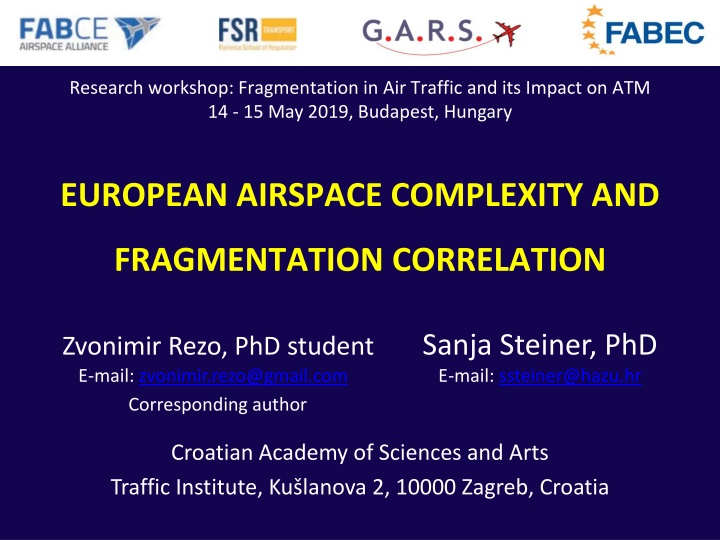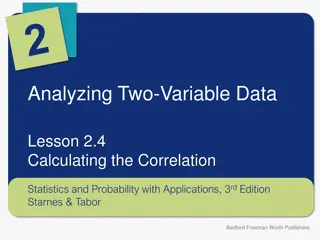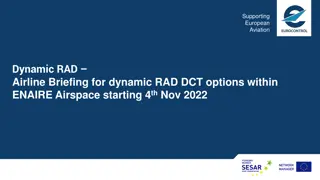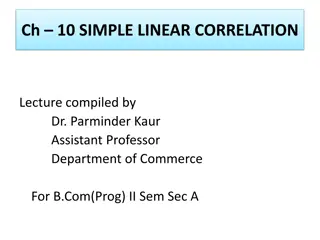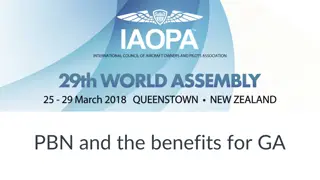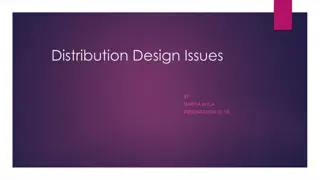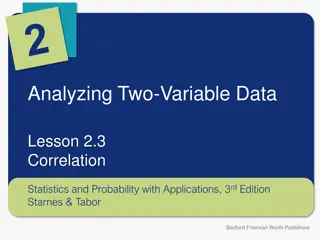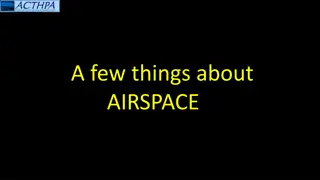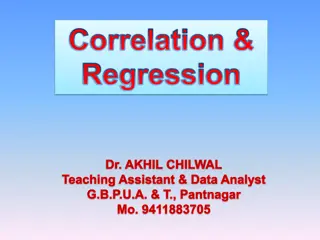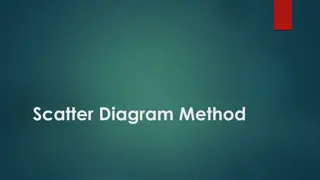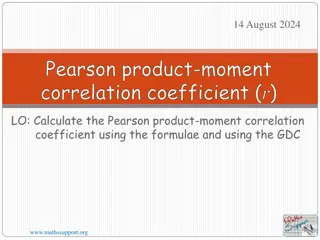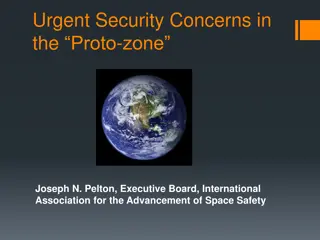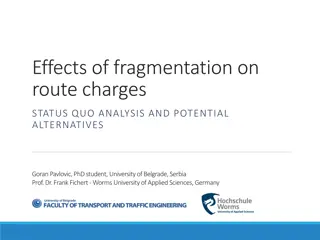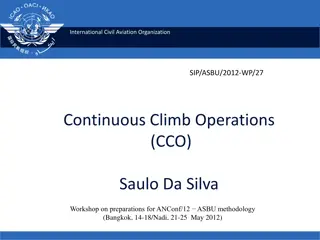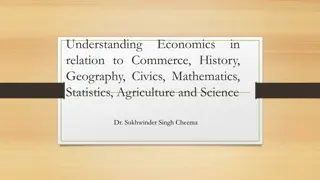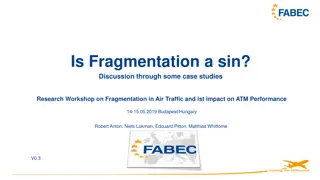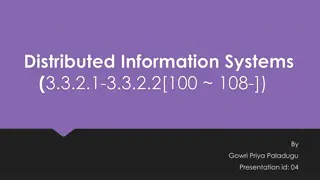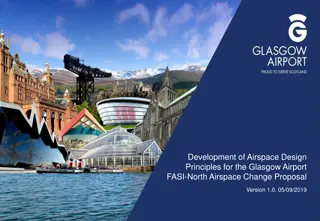EUROPEAN AIRSPACE COMPLEXITY AND FRAGMENTATION CORRELATION
This research workshop in Budapest, Hungary, focused on the correlation between European airspace complexity and fragmentation. It examined spatial clustering, hotspots, and indicators of airspace fragmentation status. Methodologies for complexity and fragmentation assessment were discussed, along with research findings and discussions on spatial patterns. The workshop aimed to understand the implications of airspace fragmentation on air traffic management performance.
Download Presentation

Please find below an Image/Link to download the presentation.
The content on the website is provided AS IS for your information and personal use only. It may not be sold, licensed, or shared on other websites without obtaining consent from the author.If you encounter any issues during the download, it is possible that the publisher has removed the file from their server.
You are allowed to download the files provided on this website for personal or commercial use, subject to the condition that they are used lawfully. All files are the property of their respective owners.
The content on the website is provided AS IS for your information and personal use only. It may not be sold, licensed, or shared on other websites without obtaining consent from the author.
E N D
Presentation Transcript
Research workshop: Fragmentation in Air Traffic and its Impact on ATM 14 - 15 May 2019, Budapest, Hungary EUROPEAN AIRSPACE COMPLEXITY AND FRAGMENTATION CORRELATION Sanja Steiner, PhD E-mail: ssteiner@hazu.hr Zvonimir Rezo, PhD student E-mail: zvonimir.rezo@gmail.com Corresponding author Croatian Academy of Sciences and Arts Traffic Institute, Ku lanova 2, 10000 Zagreb, Croatia
PRESENTATION CONTENT - Problem Definition & Research Questions; - Airspace Complexity Assessment; - Airspace Fragmentation Assessment; - Research Findings & Discussion; - Conclusions. 14/5/2019 Research workshop: Fragmentation in Air Traffic and its Impact on ATM Performance 2
Problem Definition & Research Questions: Airspace complexity and fragmentation correlation Where are located spatial clusters? How intense is the clustering? Where are located hotspots? What is the current European airspace fragmentation status in dependence of commonly accepted and measured airspace complexity indicators? Which features are most alike? Do spatial performances differ? How big and homogenous are spatial patterns? 14/5/2019 Research workshop: Fragmentation in Air Traffic and its Impact on ATM Performance 3
EUROPEAN AIRSPACE COMPLEXITY ASSESSMENT METHODOLOGY ACE Working Group on Complexity. Complexity Metrics for ANSP Benchmarking Analysis. EUROCONTROL, Brussels, 2006 Used parameters & indicators: Interaction counting Flight hours Adjusted density Complexity score Vertical Different Interacting Flows Horizontal Different Interacting Flows Structural index Speed Different Interacting Flows 14/5/2019 Research workshop: Fragmentation in Air Traffic and its Impact on ATM Performance 4
EUROPEAN AIRSPACE COMPLEXITY ASSESSMENT METHODOLOGY dz = 3000 [ft] dt = 60 [minutes] dy = 20 [NM] dx = 20 [NM] Figure 1 - 4D cell dimensions 14/5/2019 Research workshop: Fragmentation in Air Traffic and its Impact on ATM Performance 5
EUROPEAN AIRSPACE FRAGMENTATION ASSESSMENT METHODOLOGY Spatial autocorrelation Complexity score value Spatial distribution Tobler's first law of geography Everything is related to everything else, but near things are more related than distant things Used indicators: Local Indicator of Spatial autocorrelation (LISA) Global Indicator of Spatial autocorrelation (GISA) Clustering significance testing Research workshop: Fragmentation in Air Traffic and its Impact on ATM Performance 6
EUROPEAN AIRSPACE FRAGMENTATION ASSESSMENT METHODOLOGY Local Indicator of Spatial autocorrelation (LISA) Concept design close neighborhood analysis more accurate than GISA Application overview: LISA analysed whether the observed value at AoR (i) is independent of neighbouring localities AoRs (j) by taking into account sample mean (x ), number of AoRs (n) and the spatial weight (wij) of the connection between area AoR (i) and AoRs (j). 14/5/2019 Research workshop: Fragmentation in Air Traffic and its Impact on ATM Performance 7
EUROPEAN AIRSPACE FRAGMENTATION ASSESSMENT METHODOLOGY Local Indicator of Spatial autocorrelation (LISA) Modeling approach ? ?? ? ?=1 ?=1 ??? (?? ?) (?? ?)2/? ??= ? Rook Bishop Queen Figure 3 - Contiguous spatial weights matrices 14/5/2019 Research workshop: Fragmentation in Air Traffic and its Impact on ATM Performance 8
EUROPEAN AIRSPACE FRAGMENTATION ASSESSMENT METHODOLOGY Local Indicator of Spatial autocorrelation (LISA) (a) Austro Control [80,900 km2] (b) Skyeyes [39,500 km2] Figure 4 - Queen weights matrix application examples 14/5/2019 Research workshop: Fragmentation in Air Traffic and its Impact on ATM Performance 9
EUROPEAN AIRSPACE FRAGMENTATION ASSESSMENT METHODOLOGY Global Indicator of Spatial autocorrelation (GISA) Concept design Application overview: It detects spatial patterns across the entire area of interest whereby it does not reveal where significant patterns appear. It is analogous to Pearson's correlation coefficient ranging from -1 to +1 where: -1 indicates strong negative autocorrelation, 0 denotes completely random values allocation, +1 signifies strong spatial autocorrelation. 14/5/2019 Research workshop: Fragmentation in Air Traffic and its Impact on ATM Performance 10
EUROPEAN AIRSPACE FRAGMENTATION ASSESSMENT METHODOLOGY Global Indicator of Spatial autocorrelation (GISA) Modeling approach ? ? =1 ? ?=1 ?? n = 37 AoRs/ANSPs Area: 11,203,200 km2 Figure 5 Spatial overview of researched area 14/5/2019 Research workshop: Fragmentation in Air Traffic and its Impact on ATM Performance 11
EUROPEAN AIRSPACE FRAGMENTATION ASSESSMENT METHODOLOGY Clustering significance test Concept design Statistical significance (z-score) (p-value) Probability test Significant Random Figure 6 - Clustering significance testing 14/5/2019 Research workshop: Fragmentation in Air Traffic and its Impact on ATM Performance 12
RESEARCH FINDINGS & DISCUSSION Figure 7 Tabular display of research results 14/5/2019 Research workshop: Fragmentation in Air Traffic and its Impact on ATM Performance 13
RESEARCH FINDINGS & DISCUSSION Figure 8 Spatial overview of research results 14/5/2019 Research workshop: Fragmentation in Air Traffic and its Impact on ATM Performance 14
RESEARCH FINDINGS & DISCUSSION 12 Complexity score values 10 Frequency 8 6 4 2 0 2.69 - 4.77 4.78 - 6.87 6.88 - 8.96 0.59 - 2.68 11.06 - 13.15 8.97 - 11.05 25 Frequency 20 Local Moran's indexes 15 10 5 0 (-0.3) - 0.47 (-1.84) - (-1.07) (-1.08) - (-0.29) 0.48 - 1.24 1.25 - 2.01 2.02 - 2.78 Figure 9 Input data and local Moran's indexes distribution share 14/5/2019 15
RESEARCH FINDINGS & DISCUSSION Clustering significance testing results Null hypothesis testing There is no spatial clustering of the values associated with the geographic features in the study area z-score: 0.581788 p-value: 0.2810 Null hypothesis can t be rejected Result of random spatial processes 14/5/2019 Research workshop: Fragmentation in Air Traffic and its Impact on ATM Performance 16
RESEARCH FINDINGS & DISCUSSION Clustering significance testing results Spatial distribution Data distribution 0.62% 2.70% 8.11% 11.69% 87.69% 89.19% Random MHCV VHCV Figure 10 Critical values results distribution share 14/5/2019 Research workshop: Fragmentation in Air Traffic and its Impact on ATM Performance 17
RESEARCH FINDINGS & DISCUSSION Clustering significance testing results Figure 11 Spatial overview of critical values results 14/5/2019 18
CONCLUSIONS Two areas were identified as areas which spatially associate adjacent AoRs. (Figure 8) European airspace is fragmented into different homogeneous and sized spatial patterns. (Figure 9) Pattern of spatial distribution is random and clusters do not exist. (p.16 & Figure 10) Switzerland, i.e. Skyguide's AoR with the highest deviate value represent a hotspot (Figure 11) Q&A Thank you for your attention! 14/5/2019 Research workshop: Fragmentation in Air Traffic and its Impact on ATM Performance 19
Research workshop: Fragmentation in Air Traffic and its Impact on ATM 14 - 15 May 2019, Budapest, Hungary EUROPEAN AIRSPACE COMPLEXITY AND FRAGMENTATION CORRELATION Sanja Steiner, PhD E-mail: ssteiner@hazu.hr Zvonimir Rezo, PhD student E-mail: zvonimir.rezo@gmail.com Corresponding author Croatian Academy of Sciences and Arts Traffic Institute, Ku lanova 2, 10000 Zagreb, Croatia
